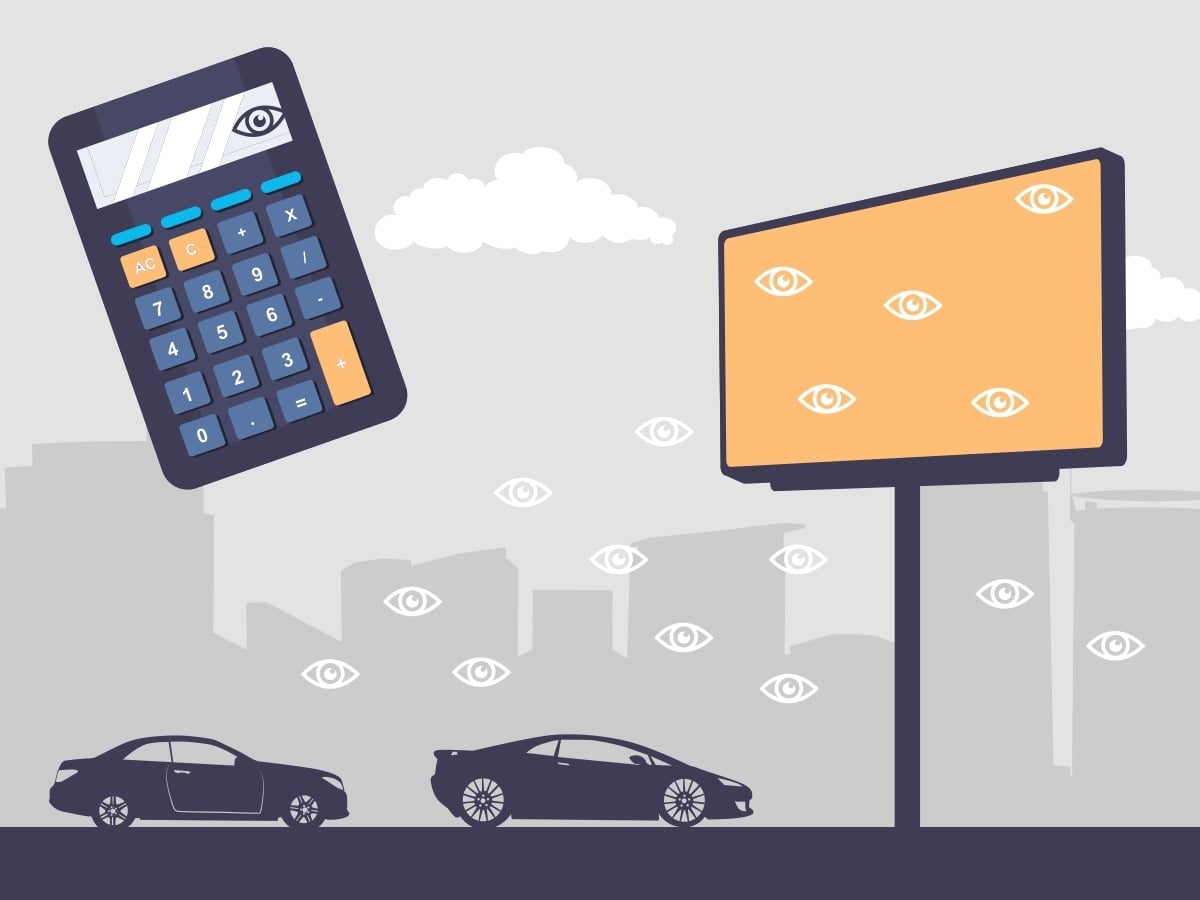Creating an advertising campaign is no small feat so it’s important to ensure that people will actually see it; it’s also important to ensure that you’re not breaking the bank to do so.
For well over a century, billboards have captured the attention of commuters and pedestrians in every market. The sheer size of a billboard and other outdoor ad placements makes them an eye-catching advertising format.
But how are billboard impressions calculated? Understanding what impressions are and how they’re measured can help you make an informed decision when you’re ready to launch an outdoor media campaign.
Here’s what we’ll cover in this post:
- What is a billboard impression?
- What does CPM mean?
- Calculating impressions
- What might influence the number of impressions?
- CPM comparisons
- How impressions appear in proposals
What Is a Billboard Impression?
A billboard impression refers to the number of times people are exposed to a billboard advertisement. This metric is essential for advertisers to gauge the reach and potential impact of their outdoor campaigns. Unlike digital impressions, which are counted each time an ad is loaded on a screen, billboard impressions are estimated based on traffic data, visibility, and other factors.
What Does CPM Mean?
When you see impression count calculations, you may encounter “CPM.” CPM stands for Cost Per Mille, where “mille” is Latin for thousand. In advertising, CPM is the cost an advertiser pays for one thousand impressions of their ad. For billboards, CPM helps advertisers understand the cost-effectiveness of their campaigns. A lower CPM indicates a more cost-efficient reach, making it a valuable metric for comparing different advertising options.
Calculating Billboard Impressions
Many billboard companies leverage data from Geopath, a nonprofit organization that provides the data and insights needed to measure billboard impressions accurately. Geopath uses sophisticated methodologies and technology to analyze traffic patterns, demographic information, and other variables to deliver precise impression data to advertisers.
Here are some of the most significant factors examined when calculating billboard impressions.
Traffic Data
Traffic data includes the number of vehicles and pedestrians passing by the billboard. Traffic data is made public—typically collected by transportation authorities and other relevant organizations.
Visibility Adjustments
Not all billboards are equally visible. Factors like the billboard’s size, lighting, and angle relative to the road can affect its visibility. Adjustments are made to the raw traffic data to account for these variables. For instance, if a board is not illuminated, the number of hours during which it’s considered viewable decrease compared to one that is illuminated.
Dwell Time
Digital marketers will be familiar with this phrase since it’s used to describe how long a user stays on a webpage when visiting. In the context of outdoor media, dwell time refers to the amount of time people spend looking at the billboard. This can vary based on the location of the billboard and the speed of traffic. For example, billboards on highways may have shorter dwell times compared to those in urban areas with slower-moving traffic.
What Might Influence the Number of Impressions?
There are a number of different factors that might cause a fluctuation in the number of impressions. Those can include, but are not limited to:
- Whether or not the board is illuminated (illuminated boards are visible at night)
- The type of billboard (static, digital, tricolor)
- If there is a special event or holiday during your campaign duration
- The direction you board faces
You shouldn’t have to guess about these factors when deciding on the right billboard for your needs. Illumination and facing (cardinal direction that an OOH structure faces) should be indicated on your proposal.
How Does Billboard CPM Compare to Other Advertising Channels?
Though social media advertising has become a go-to choice for many brands, it may not be as cost-effective when considering CPM. Below is a CPM comparison chart by Solomon Partners, highlighting the different cost per impressions of popular advertising formats.
When people ask “is billboard advertising expensive?”, we often cite CPMs. While billboards may have a higher upfront cost, it takes less dollars to generate a certain number of impressions, leading to a higher return on investment (ROI).

Digital Advertising
Digital advertising platforms provide real-time impression data, making it easy to track and optimize campaigns. However, digital impressions can sometimes suffer from issues like ad fraud, ad blocking, and viewability concerns. Check out our blog post on social media vs. traditional media for a deeper dive on how digital advertising measures up to OOH.
Television and Radio
Television and radio ads reach broad audiences but lack the granularity of impression data available for billboards and digital ads. These mediums rely on ratings and estimates, which can be less precise. Not only that, but an increasing number of people are ‘cord cutting’ and choosing streaming services over traditional cable.
Print Advertising
Print advertising, such as magazines and newspapers, offers limited impression data. Circulation numbers provide a rough estimate, but they don’t account for actual ad exposure. Furthermore, with many publications going digital, print media just doesn’t have the hold on society that it used to.
How Alluvit Media Shows Impressions in Proposals
Alluvit Media provides no-obligation interactive proposals for brands looking to launch an OOH campaign. By leveraging Geopath and other data sources, we help support advertisers in making informed decisions about their billboard placements.
We note the weekly impression counts, which are calculated based on the average number of passengers or persons (ages 18 and older) in cars, or other vehicles, that could be potentially exposed to a billboard for either 12 hours (unilluminated) or 18 hours (illuminated) on an average day.
Here is a snapshot of an actual proposal to give you a sense of what information is available to you.

Submit a brief online form to get connected with a media coordinator who can help locate the best outdoor advertising placements in your target market.
